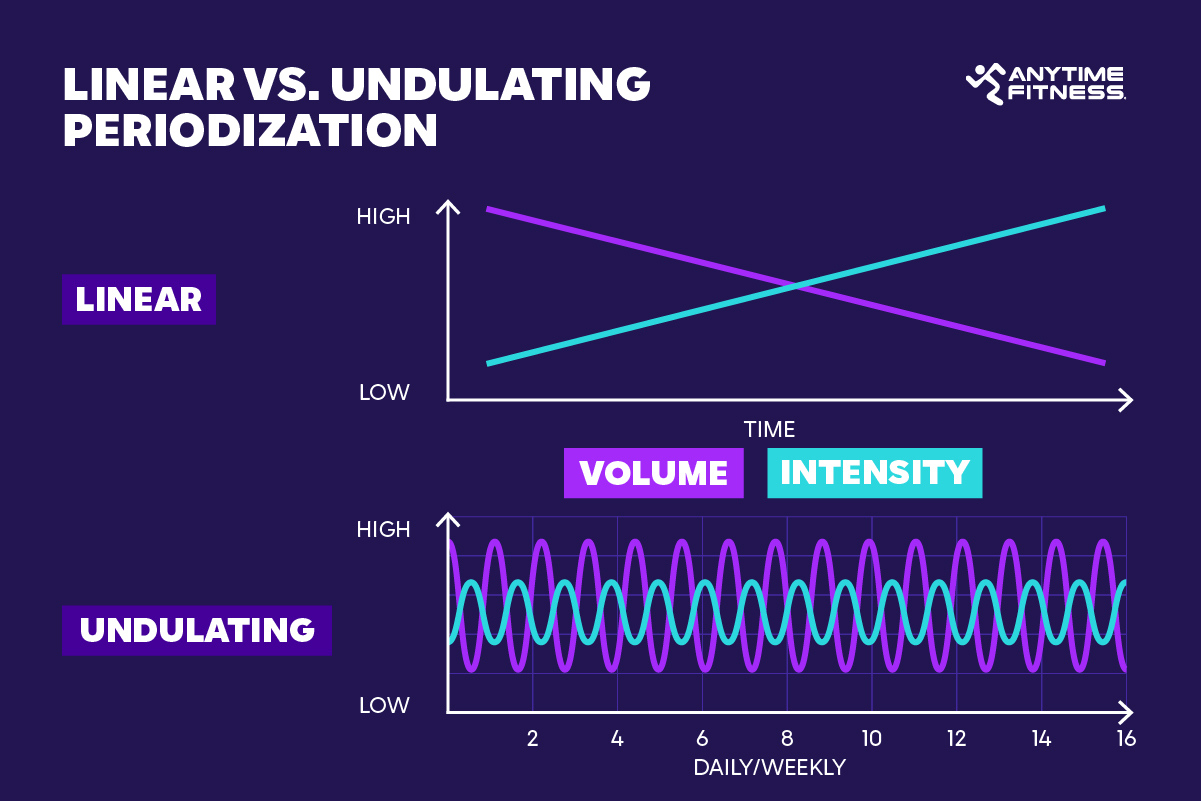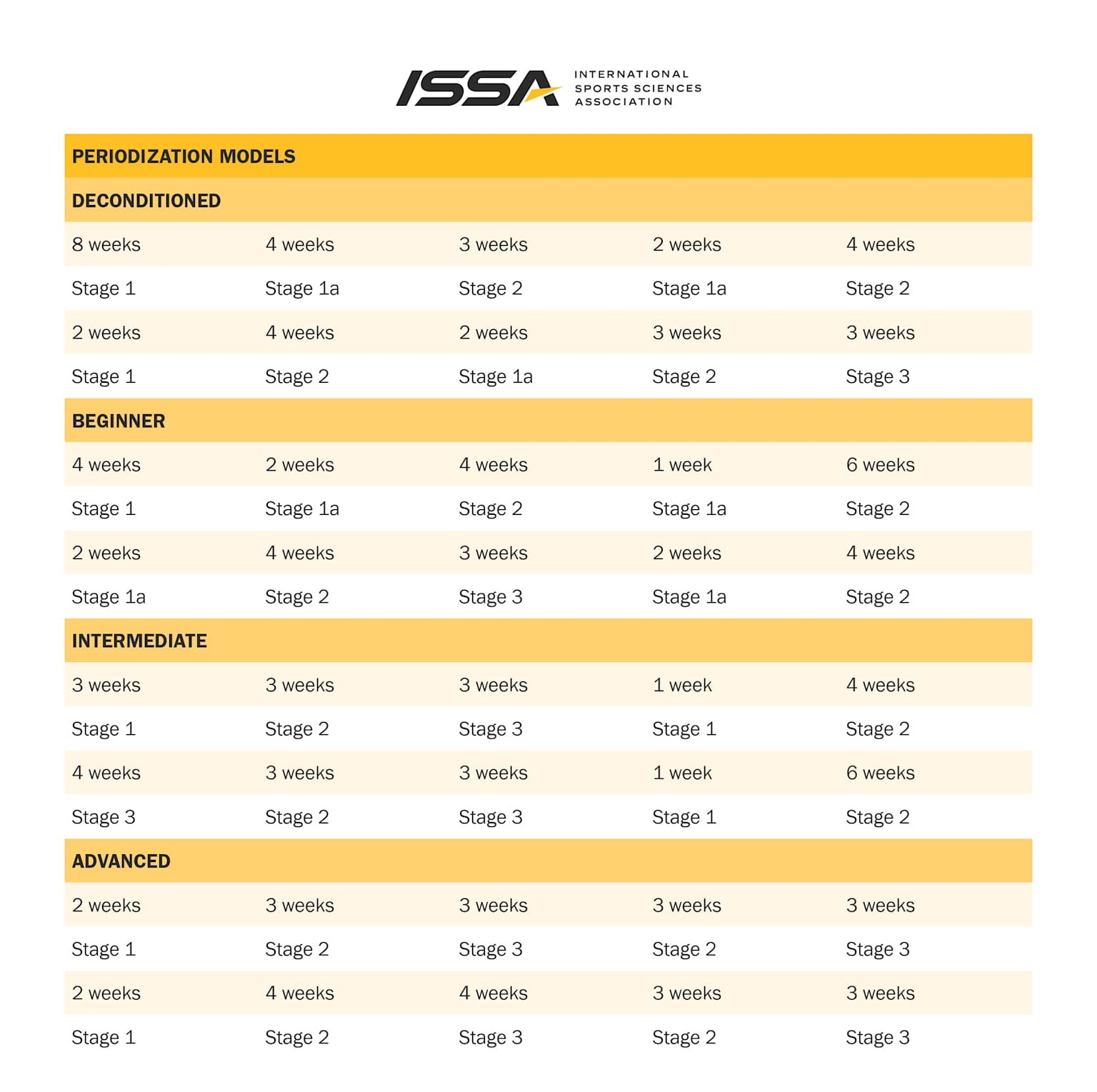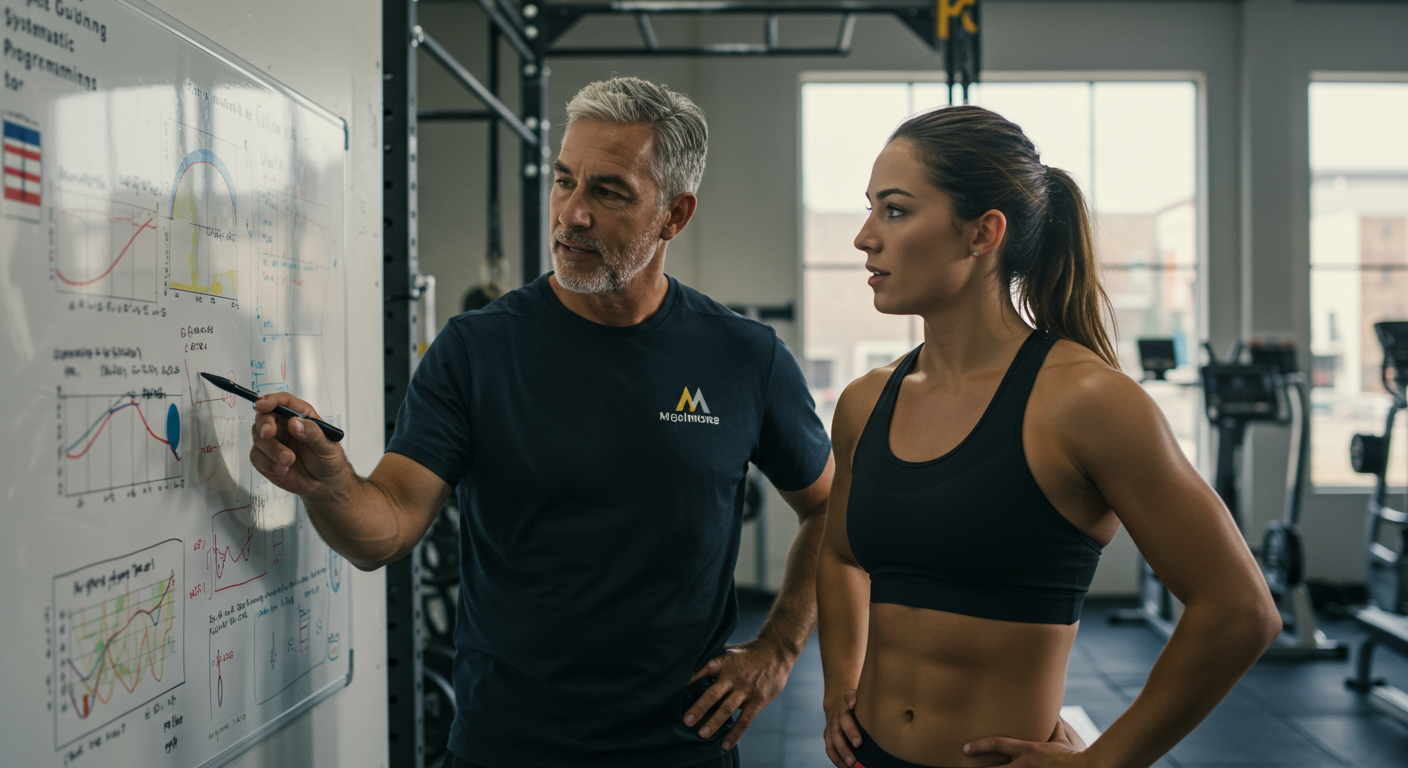The Complete Guide to Training Periodization and Systematic Programming for Elite Athletes
Training periodization stands as the cornerstone of elite athletic development, serving as the master blueprint that transforms raw talent into world-class performance. This systematic approach to training manipulation has revolutionized how athletes prepare for competition, moving beyond random workout sessions to create carefully orchestrated progressions that optimize adaptation while minimizing injury risk.

Figure 1: Visual comparison showing the difference between linear and undulating periodization approaches
Source: Anytime Fitness - Linear vs Undulating Periodization
What is Training Periodization?
Training periodization is the deliberate manipulation of training variables—including intensity, volume, frequency, and exercise selection—over specific time periods to achieve optimal performance adaptations[1]. This systematic approach was first formalized by Russian physiologist Leo Matveyev in the 1960s after analyzing Soviet athletes' performances in the 1952 and 1956 Olympics[2].
The fundamental principle underlying periodization is the General Adaptation Syndrome (GAS), developed by Hans Selye, which describes how the body responds to stress through three phases: alarm, adaptation, and exhaustion[2]. By strategically applying and removing training stress, coaches can guide athletes through continuous adaptation cycles while preventing the exhaustion phase that leads to overtraining.
The Three Pillars of Periodization
Macrocycles: The Big Picture Framework
Macrocycles represent the longest planning period, typically spanning an entire training year or Olympic cycle[1]. These overarching frameworks provide the structural foundation for all training decisions. For competitive athletes, macrocycles are usually designed around major competitions, ensuring peak performance coincides with the most important events.
A typical annual macrocycle includes:
- Preparation Phase (4-6 months): Building aerobic base and fundamental strength
- Competition Phase (3-4 months): Sport-specific training and performance refinement
- Transition Phase (1-2 months): Active recovery and regeneration
Mesocycles: Building Blocks of Progress
Mesocycles are 3-6 week training blocks within the macrocycle that focus on specific adaptations[1]. These intermediate cycles allow coaches to progressively develop targeted qualities while incorporating planned recovery phases. The traditional approach involves three weeks of progressive loading followed by one week of reduced intensity for adaptation and recovery[1].
Common mesocycle types include:
- Accumulation: High-volume, moderate-intensity training
- Intensification: Reduced volume with increased intensity
- Realization: Competition-specific training and peaking
Microcycles: Weekly Training Units
Microcycles represent the smallest planning units, typically lasting one week[7]. These short-term cycles allow for precise manipulation of daily training variables while maintaining the overall mesocycle direction. Effective microcycle design considers:
- Training frequency and session distribution
- Recovery time between high-intensity sessions
- Skill practice and technical work timing
- Load progression and variation

Figure 2: ISSA periodization model showing training phases and durations for different fitness levels
Source: ISSA Online - A Guide to Periodization for Personal Trainers
Major Periodization Models
Linear Periodization: The Classic Approach
Linear periodization follows Matveyev's original model, gradually progressing from high-volume, low-intensity training toward low-volume, high-intensity work as competition approaches[2]. This approach works exceptionally well for beginners and athletes with single-peak seasons.
Advantages:
- Simple to understand and implement
- Excellent for strength development
- Ideal for novice athletes
- Clear progression pathway
Limitations:
- May not suit athletes with multiple competitions
- Can lead to fitness decay during long competitive seasons
- Less flexible for varying competitive demands
Undulating Periodization: Dynamic Variation
Undulating (or non-linear) periodization varies training intensity and volume more frequently, sometimes daily or weekly[10]. Research consistently shows superior strength gains compared to linear models in trained athletes[11][17].
Daily Undulating Periodization (DUP) example:
- Monday: Hypertrophy (3-4 sets, 8-12 reps, 70-80% 1RM)
- Wednesday: Strength (3-5 sets, 3-6 reps, 80-90% 1RM)
- Friday: Power (3-4 sets, 1-3 reps, 40-60% 1RM explosive)
Benefits:
- Prevents training monotony
- Maintains multiple fitness qualities simultaneously
- Better for athletes with frequent competitions
- Reduces accommodation and plateaus
Block Periodization: Concentrated Loading
Block periodization involves highly concentrated workloads targeting specific adaptations over 2-4 week periods[13]. Each block focuses intensively on one primary training quality, allowing for maximum adaptation before moving to the next focus.
Typical block sequence:
- Accumulation Block: Volume emphasis, aerobic development
- Intensification Block: High-intensity, neuromuscular focus
- Realization Block: Competition-specific, peaking activities
This model works particularly well for sports requiring multiple peak performances throughout the year[13].
Reverse Linear Periodization: Endurance Focus
Reverse linear periodization begins with high-intensity, low-volume training and gradually increases volume while decreasing intensity[15]. This approach proves superior for endurance sports where sustained aerobic capacity is paramount.
Applications:
- Endurance sports (marathon, cycling, triathlon)
- Sports with long competitive seasons
- Athletes prioritizing aerobic capacity development
The Science Behind Systematic Programming
Progressive Overload Principles
Effective periodization relies on progressive overload—the gradual increase in training demands that forces continuous adaptation[5]. This can be achieved through:
- Volume progression: Increasing total training load
- Intensity progression: Raising effort levels or resistance
- Frequency progression: Adding training sessions
- Complexity progression: Advancing exercise difficulty
Supercompensation Theory
The supercompensation model explains how training stress temporarily reduces performance capacity, followed by an adaptation period that elevates performance above baseline levels[3]. Optimal periodization times subsequent training sessions to occur during peak supercompensation, maximizing cumulative adaptations.
Autoregulation: Individualizing the Process
Modern periodization increasingly incorporates autoregulation—real-time adjustment of training loads based on individual readiness and performance[16]. This approach uses tools like:
- Rate of Perceived Exertion (RPE) scales
- Reps in Reserve (RIR) assessments
- Velocity-based training metrics
- Subjective wellness questionnaires

Figure 3: Exercise progression examples showing systematic advancement in movement complexity
Source: Rowing Stronger - Exercise Progression for Masters Rowers
Practical Implementation Strategies
Step 1: Establish Clear Goals and Timelines
Begin by identifying specific, measurable objectives and their target achievement dates. Consider:
- Primary competition dates
- Secondary performance markers
- Testing and evaluation periods
- Recovery and transition phases
Step 2: Assess Current Fitness Levels
Comprehensive baseline testing provides the foundation for program design:
- Strength assessments (1RM testing)
- Aerobic capacity evaluation (VO2 max, lactate threshold)
- Movement quality screening
- Sport-specific skill evaluation
Step 3: Design the Macrocycle Structure
Map out the annual plan with clear phase divisions:
- Allocate time for each major phase
- Identify peak competition periods
- Plan transition and recovery phases
- Build in flexibility for adjustments
Step 4: Develop Mesocycle Progressions
Create 3-6 week blocks with specific focus areas:
- Define primary training objectives
- Plan volume and intensity progressions
- Schedule deload weeks appropriately
- Integrate testing and evaluation points
Step 5: Structure Effective Microcycles
Design weekly patterns that support mesocycle goals:
- Balance high and low-intensity sessions
- Ensure adequate recovery between demanding workouts
- Sequence technical and physical training appropriately
- Monitor athlete response and adjust accordingly
Common Periodization Mistakes to Avoid
Mistake 1: Neglecting Deload Weeks
Deload weeks—planned periods of reduced training stress—are essential for adaptation and recovery[23]. Skipping these recovery phases often leads to overtraining and performance plateaus. Implement deloads every 3-4 weeks by reducing volume by 40-60% while maintaining movement patterns.
Mistake 2: Mismatching Model to Goals
Different periodization models serve different purposes[20]. Using strength-focused linear periodization for hypertrophy goals, or applying endurance-oriented reverse periodization to power sports, will produce suboptimal results.
Mistake 3: Excessive Complexity Without Progression
Some coaches create overly complex programs that lack clear progression[20]. While variation prevents staleness, the fundamental principle of progressive overload must remain the foundation of any effective program.
Mistake 4: Ignoring Individual Differences
Cookie-cutter approaches fail to account for individual responses to training stress[19]. Successful periodization requires ongoing monitoring and adjustment based on athlete feedback and performance metrics.
Mistake 5: Poor Recovery Integration
Periodization extends beyond training sessions to include comprehensive recovery strategies[18]. Neglecting sleep, nutrition, stress management, and active recovery undermines even the best-designed programs.
Advanced Periodization Concepts
Conjugate Method Integration
The conjugate method simultaneously develops multiple fitness qualities through varied training stimuli[14]. This approach works well for sports requiring diverse physical attributes and can be integrated within other periodization models.
Technology-Enhanced Programming
Modern periodization increasingly leverages technology for enhanced precision:
- Wearable devices for load monitoring
- Heart rate variability for recovery assessment
- Velocity-based training for real-time adjustments
- Software platforms for program tracking and analysis[22]
Team Sport Considerations
Team sports present unique periodization challenges due to:
- Unpredictable game schedules
- Varying individual needs within the team
- In-season maintenance requirements
- Multiple competition phases

Figure 4: Comprehensive periodization table showing integration of training, recovery, nutrition, and psychological factors
<span style={{ fontSize: 'smaller' }}><em>Source: NSCA (example image via Cloudinary PPLX) - Integrated Periodization Table</em></span>
Measuring Periodization Success
Performance Indicators
Track progress through multiple metrics:
- Primary performance measures: Sport-specific tests and competition results
- Secondary indicators: Strength, power, and endurance benchmarks
- Process markers: Training load tolerance and recovery rates
- Subjective measures: Motivation, energy levels, and perceived effort
Adjustment Protocols
Effective periodization requires responsive modifications:
- Weekly performance monitoring
- Monthly program evaluation and adjustment
- Quarterly comprehensive assessment
- Annual program review and redesign
Key Findings Summary
Training periodization and systematic programming represent the foundation of elite athletic development, providing structured pathways from baseline fitness to peak performance. The key findings from current research and practice include:
Multiple Models Work: Linear, undulating, block, and reverse periodization all produce positive results when properly applied to appropriate populations and goals.
Individualization is Critical: While general principles apply universally, successful periodization requires customization based on individual athlete characteristics, training history, and response patterns.
Progressive Overload Remains Central: Regardless of the periodization model selected, systematic progression in training demands drives adaptation and improvement.
Recovery Integration is Essential: Deload weeks, sleep optimization, and comprehensive recovery strategies are not optional components but fundamental requirements for successful periodization.
Technology Enhances Precision: Modern monitoring tools enable more precise load management and responsive program adjustments, improving periodization effectiveness.
Long-term Planning Produces Superior Results: Athletes following systematic periodization programs consistently outperform those using random or non-periodized approaches.
Flexibility Within Structure: The most successful programs maintain overall periodization structure while allowing tactical adjustments based on real-time feedback and changing circumstances.
Mastering training periodization and systematic programming requires understanding both the science and art of athlete development. By applying these evidence-based principles while maintaining individual focus and practical flexibility, coaches can guide athletes toward their highest potential while minimizing injury risk and optimizing long-term development.
For more insights on elite athletic development and evidence-based training strategies, explore our comprehensive guides on recovery optimization, mental training, and multidisciplinary support systems.



